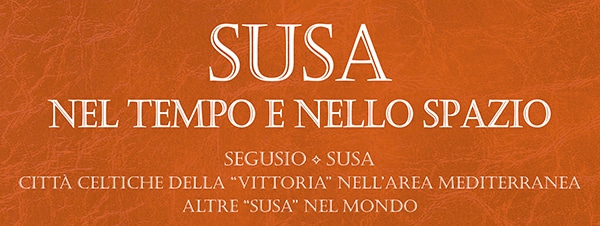SUSA
Susa è una bella città, originariamente fondata dai Celti, che in seguito si opposero alle mire espansionistiche dell’Impero Romano, con cui successivamente strinsero alleanza. La città attira visitatori grazie alle sue antiche rovine romane e ai monumenti medievali e alle sue bellezze naturalistico-paesaggistiche. Tra le rovine romane, le più importanti sono i resti di un altare celtico e l’arco di Augusto (I sec. a.C.) eretto dal re Cozio per celebrare il trattato di pace stipulato con Augusto; altre evidenze archeologiche sono le adiacenti terme romane, l’anfiteatro e un acquedotto – l’anfiteatro è ancora oggi utilizzato per spettacoli dal vivo.
Costruita più recentemente, la cattedrale medievale di Susa – la cattedrale di San Giusto dell’XI secolo – è una chiesa in stile romanico che un tempo faceva parte di un complesso abbaziale e presenta interessanti elementi decorativi come un campanile e ben conservati affreschi sulle pareti esterne. All’interno si possono ammirare anche alcune opere notevoli risalenti al XIV e XV secolo. Susa riuscì a ricoprire un ruolo attivo all’epoca di Olderico Manfredi conte di Torino e marchese di Susa agli inizi dell’XI secolo. Nel Castello di Susa nacque anche la contessa Adelaide – figlia di Olderico e moglie di Oddone. Il Castello subì nel tempo molte trasformazioni prima di diventare la dimora della contessa di Susa. L’attuale struttura è il risultato di ristrutturazione effettuate in periodi successivi.
Al periodo risorgimentale si lega la riqualificazione urbanistica di Susa, che registra la costruzione di diversi edifici tra cui il nuovo ospedale e le scuole elementari.
La modernizzazione delle vie di comunicazione e la costruzione della linea ferroviaria Torino-Susa (1854) sono di fondamentale importanza per l’economia della città.
Oggi, Susa registra la presenza di circa 6500 abitanti e dista 54 km da Torino, capoluogo piemontese. È considerata “PORTA D’ITALIA” perché da sempre rappresenta lo snodo di importanti vie di comunicazione verso la Francia e l’Europa occidentale. Nel corso del XX secolo ha subito una significativa riduzione delle industrie e dell’artigianato, progressivamente sostituiti dal turismo come fonte di reddito.
Susa ha una grande tradizione culturale. Ha uno straordinario patrimonio archeologico, come la COLLEZIONE LAPIDEA – conservata nel Seminario – i tesori esposti nel Museo Diocesano di Arte Sacra e manufatti di diversi periodi storici visibili nel Museo Civico.
Non meno importanti sono gli itinerari – di peculiare valore quelli NATURALISTICI e in particolare la Via Francigena e Micaelica. Poche città come Susa possono vantare un insieme così ampio di testimonianze storico-artistiche delle varie epoche storiche passate.
Susa is a pleasant town, originally established by the Celts as they were holding out against the expanding Roman empire. The town attracts visitors because of its important Roman ruins and medieval monuments, and because Susa has easy access to spectacular countryside. The most important of the roman ruins of Susa are the remains of a Celtic altar and the first century A.D. arch of Augustus erected by King Cottius to celebrate the peace treaty he had signed with Augustus and parts of the adjacent Roman baths, the Roman amphitheater and a Roman aqueduct – the amphitheater is still used for live performances today.
Built more recently, the medieval cathedral in Susa – the XI century Cathedral of San Giusto – is a roman style church which once formed part of an abbey complex and has interesting decorative features such as a campanile and some frescoes on the outside walls. Inside you can also see some notable artworks dating from the XIV and XV centuries.Susa regained an active role under Ulric Manfred, count of Turin and marquis of Susa, in the early XI century. Countess Adelaide was born in the Castle – she was Ulric Manfred’s daughter and Oddon’s wife. The castle was transformed several times and experienced many vicissitudes before becoming the home of the Marquise of Susa. The current structure is the result of the renovation carried out in subsequent periods.
The urban redevelopment of Susa registers, among other things, the construction of various buildings including the new hospital and elementary schools. The modernization of the communication routes and the construction of the Turin-Susa railway line (1854) are of fundamental importance for the economy of Susa. In this context of rebirth there was the establishment of numerous factories.
Today, Susa records the presence of about 6500 inhabitants and is 54 km from Turin, the capital of the Piedmont Region. It is considered “PORTA D’ITALIA” because it has always been connected to important routes of communication to France and to Western Europe. During the twentieth century it saw its industrial and handicraft presence progressively reduced – replaced by the tourism.
Susa has a great cultural tradition. It has extraordinary archeological heritage, like the LAPIDEA COLLECTION – preserved in the Susa Seminary – the treasures exhibited in the Diocesan Museum of Sacred Art and artifacts from different historical periods visible in the Civic Museum.
No less important are the itineraries – of particular value the NATURALISTIC itineraries and particularly the Via Francigena and Micaelica. As a tourist destination, Susa preserve testimonies related to such a vast historical journey – starting from the Celtic period up to the contemporary age.
